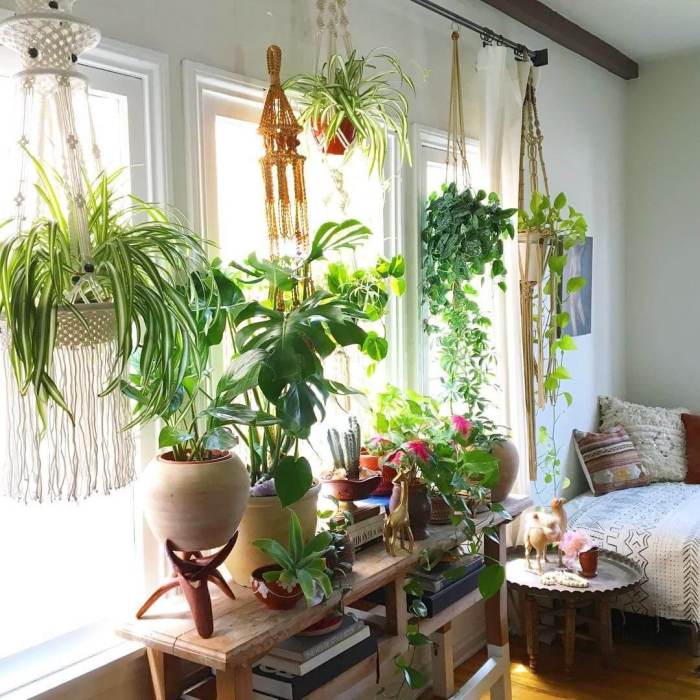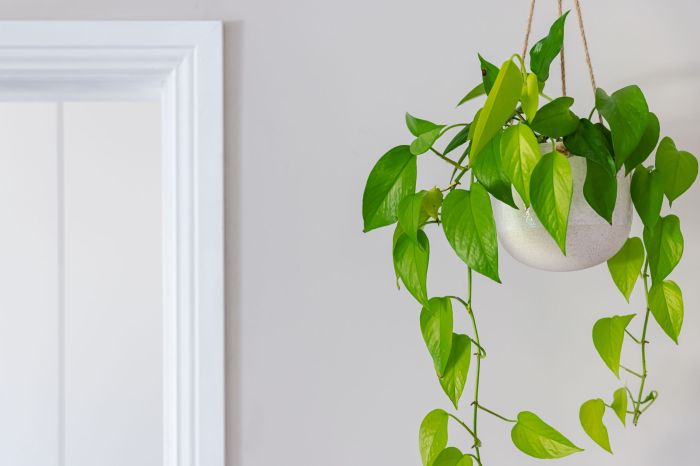Inside hanging plants have become increasingly popular as homeowners seek to bring a touch of nature into their indoor spaces. These versatile plants offer a wide range of benefits, from improving air quality to reducing stress. In this comprehensive guide, we will explore the different types of indoor hanging plants, their benefits, and how to choose and care for them.
Types of Inside Hanging Plants
Indoor hanging plants add a touch of greenery and life to any room. They come in a variety of shapes, sizes, and colors, and can be used to create a variety of different looks. Some of the most popular types of indoor hanging plants include:
Spider Plant (Chlorophytum comosum)
Spider plants are one of the most popular indoor hanging plants because they are easy to care for and can tolerate a wide range of conditions. They have long, narrow leaves that are variegated with white or cream. Spider plants produce small white flowers that are followed by plantlets, which can be used to propagate new plants.
Pothos (Epipremnum aureum)
Pothos is another popular indoor hanging plant that is easy to care for. It has heart-shaped leaves that are variegated with green, white, or yellow. Pothos can tolerate low light conditions and does not need to be watered very often.
String of Pearls (Senecio rowleyanus)
String of pearls is a unique and beautiful indoor hanging plant. It has long, trailing stems that are covered in small, round leaves that resemble pearls. String of pearls prefers bright light and should be watered sparingly.
Air Plant (Tillandsia spp.)
Air plants are a type of epiphyte, which means that they grow on other plants or objects. They do not need to be planted in soil and can be displayed in a variety of ways, such as in terrariums, on driftwood, or in hanging baskets.
Air plants prefer bright, indirect light and should be watered by misting them regularly.
Choosing the Right Hanging Plant
When choosing an indoor hanging plant, it is important to consider the following factors:
- The amount of light the plant will receive
- The humidity level of the room
- The amount of time you have to care for the plant
- The size of the plant
Once you have considered these factors, you can choose an indoor hanging plant that is right for you and your home.
Benefits of Inside Hanging Plants

Indoor hanging plants offer a plethora of advantages, enhancing both the ambiance and well-being within living spaces. Their presence not only purifies the air, but also reduces stress levels and infuses a touch of nature’s tranquility into indoor environments.
Hanging plants serve as effective air purifiers, absorbing harmful pollutants and toxins from the atmosphere. Studies have demonstrated that certain plant species, such as spider plants and peace lilies, are particularly adept at removing formaldehyde and benzene, common indoor air contaminants.
Reducing Stress
The presence of indoor plants has been shown to have a calming effect on the human mind. Studies indicate that exposure to greenery can reduce stress levels, promote relaxation, and improve overall well-being. The act of caring for plants can also provide a sense of purpose and fulfillment, further contributing to mental health benefits.
Privacy and Room Division
Hanging plants can be strategically placed to create a sense of privacy or divide a room. Larger hanging plants, such as ferns or ivy, can be used to create a natural screen, separating different areas within a room without the need for physical barriers.
This technique is particularly useful in open-concept living spaces, where privacy and separation are desired.
Interior Design Styles
Hanging plants can complement various interior design styles, from traditional to modern. In classic or Victorian-style homes, trailing plants like ivy or pothos add a touch of elegance and charm. For contemporary or minimalist spaces, succulents or air plants in geometric planters create a sleek and sophisticated look.
In bohemian-inspired interiors, macrame hangers and woven baskets housing hanging plants add a touch of eclectic flair.
Choosing the Right Inside Hanging Plants

Selecting the right hanging plants for indoor environments requires careful consideration of various factors. Lighting conditions, humidity levels, and space constraints play crucial roles in determining suitable plant choices. Additionally, personal preferences and compatibility with existing décor should be taken into account.
Hanging plants bring life and greenery to indoor spaces, creating a sense of tranquility and freshness. Whether it’s a lush fern or a cascading ivy, these plants add a touch of nature to any room. To enhance their beauty and functionality, consider using indoor hanging pots . These pots come in a variety of styles and materials, allowing you to customize the look of your hanging plants and complement your existing decor.
Light Availability
Light is essential for plant growth and should be considered when choosing hanging plants. Some plants thrive in bright, indirect light, while others prefer shaded areas. It’s important to assess the light conditions in your space and select plants that can adapt to those conditions.
Humidity
Humidity levels also affect plant health. Some plants, such as ferns and orchids, prefer high humidity environments, while others, like succulents and cacti, tolerate drier conditions. Consider the humidity levels in your home or office and choose plants that are compatible with those conditions.
Space Constraints, Inside hanging plants
Space constraints should be considered when selecting hanging plants. Some plants, like trailing ivy, can spread horizontally and require ample space. Others, like hanging baskets, are more compact and suitable for smaller spaces. Choose plants that fit well within the available space.
Compatibility and Preferences
Consider the existing décor and personal preferences when choosing hanging plants. Some plants, like spider plants, have a classic look that complements various styles. Others, like air plants, have a more modern and unique appearance. Select plants that enhance the overall aesthetic and match your personal taste.
Healthy Plants
When selecting hanging plants, it’s essential to choose healthy specimens. Look for plants with lush, green foliage and no signs of pests or diseases. Avoid plants with wilted or yellowing leaves or broken stems. Proper care and maintenance are crucial to keep your hanging plants healthy and thriving.
Creative Ways to Display Inside Hanging Plants
Incorporating hanging plants into your indoor decor not only adds a touch of greenery but also offers endless possibilities for creative displays. Explore various innovative ways to showcase your indoor hanging plants, transforming your living space into a lush oasis.
From macrame hangers that add a bohemian touch to ceiling hooks that create a cascading effect, the options are limitless. Utilize wall-mounted shelves to create a vertical garden or repurpose old jars and baskets as unique plant holders. Get creative and let your imagination soar as you transform your home into a botanical haven.
DIY Hanging Plant Displays
Embrace your creativity and craft your own hanging plant displays using repurposed materials. Transform old jars into hanging terrariums, creating miniature ecosystems that thrive indoors. Utilize empty wine bottles as unique planters, suspending them with twine or wire for a rustic charm.
Upcycle old baskets by lining them with moss and adding hanging chains, creating cozy homes for your favorite plants.
Vertical Gardens and Living Walls
Maximize space and create a living work of art with vertical gardens and living walls. Utilize hanging planters to create a vertical tapestry of greenery, transforming a bare wall into a lush oasis. Arrange plants of varying sizes and textures to create a dynamic and eye-catching display.
Inside hanging plants are a popular choice for adding greenery and style to your home. They can be used to create a variety of looks, from lush and tropical to minimalist and modern. If you’re looking for ideas on how to use hanging plants indoors, be sure to check out hanging plants indoor . This website offers a wide variety of tips and inspiration for using hanging plants to create a beautiful and inviting space.
Consider using a combination of trailing plants, such as pothos or ivy, and upright varieties, such as ferns or succulents, to add depth and interest.
Care and Maintenance of Inside Hanging Plants
Maintaining the health and beauty of indoor hanging plants requires regular care and attention. Proper watering, fertilizing, and pruning are essential for their well-being. Additionally, understanding and addressing common problems that may arise can help prevent decline and ensure their continued vitality.
Watering
- Determine the specific watering needs of each plant species.
- Water thoroughly when the soil feels dry to the touch, avoiding overwatering.
- Allow excess water to drain from the pot to prevent root rot.
Fertilizing
Fertilize hanging plants regularly, especially during the growing season.
- Use a balanced liquid fertilizer diluted to half strength.
- Fertilize every two to four weeks, depending on the plant’s needs.
Pruning
- Prune hanging plants to remove dead or damaged leaves and stems.
- Encourage bushier growth by pinching back new shoots.
- Prune excessively long vines to maintain a manageable size.
Common Problems and Solutions
- Yellowing leaves:Indicates overwatering or nutrient deficiency. Reduce watering frequency and fertilize regularly.
- Brown leaf tips:Caused by underwatering or low humidity. Water more frequently and increase humidity levels.
- Mealybugs:Small, white insects that feed on plant sap. Use a cotton swab dipped in rubbing alcohol to remove them.
- Spider mites:Tiny, spider-like pests that cause stippling on leaves. Treat with a miticide.
Last Word
Whether you’re a seasoned plant enthusiast or a novice gardener, incorporating indoor hanging plants into your home is a rewarding experience. They add a touch of beauty, improve your well-being, and can be easily incorporated into any décor style. With proper care and maintenance, your indoor hanging plants will thrive for years to come.
Questions Often Asked
What are the most popular types of indoor hanging plants?
Some of the most popular indoor hanging plants include pothos, spider plants, ferns, and philodendrons.
How do I choose the right indoor hanging plant for my space?
Consider factors such as light availability, humidity, and space constraints when choosing indoor hanging plants. It’s also important to choose plants that are compatible with your existing décor and personal preferences.
How do I care for indoor hanging plants?
Indoor hanging plants require regular watering, fertilizing, and pruning. It’s also important to check for pests and diseases and address them promptly.